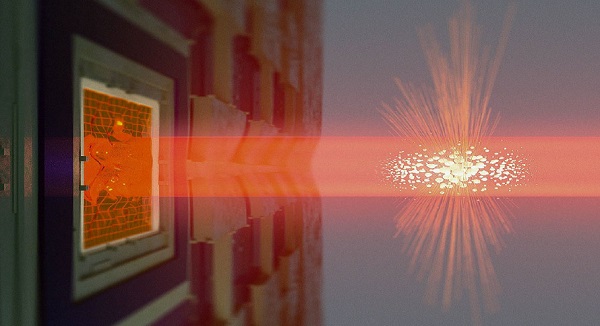Disparate, Entangled Objects Hold Promise for Next-Level Quantum Mechanics
KØBENHAVN, Denmark, Oct. 12, 2020 — Researchers at the Niels Bohr Institute at the University of Copenhagen have entangled two very different quantum objects — a mechanical oscillator/vibrating dielectric membrane, and a cloud of atoms with each atom acting as a tiny magnet. In addition to wholly disparate, the objects are much larger than classically entangled object pairs, giving the development potential applications in ultraprecise sensing and quantum communications.
The objects acquired the ability to be entangled by physically connecting with photons. As photons moved between the two objects, a correlation formed, linking the motion of the objects. The correlated motion of the entangled objects present a precision better than the zero-point motion — the residual uncorrelated motion of all matter that occurs even at absolute zero.
As individual components, atoms are useful in processing quantum information. The membrane — and mechanical quantum systems in general — are useful in storing quantum information.
“Quantum mechanics is like a double-edged sword. It gives us wonderful new technologies, but also limits precision of measurements which would seem just easy from a classical point of view,” said research team member Michal Parniak.
Entangled systems can remain perfectly correlated even when positioned at a distance from each other. This dynamic has puzzled researchers since the beginning of the study of quantum mechanics more than 100 years ago.
“The bigger the objects, the farther apart they are, the more disparate they are, the more interesting entanglement becomes from both fundamental and applied perspectives,” said Eugene Polzik, professor of physics at the Niels Bohr Institute.


Light propagates through the atomic cloud shown in the center and then falls onto the SiN membrane shown on the left. As a result of interaction with light the precession of atomic spins and vibration of the membrane become quantum correlated. This is the essence of entanglement between the atoms and the membrane. Courtesy of Niels Bohr Institute.
The technique has potential for sensing in oscillators of any size. The Laser Interferometer Gravitational-Wave Observatory (LIGO) senses and measures extremely faint waves caused by astronomical events in deep space. The waves shake the mirrors of the interferometer, which allows them to be sensed, though the sensitivity is limited by quantum mechanics as the mirrors are also shaken by zero-point fluctuations.
In principle, it is possible to generate entanglement of the LIGO mirrors with an atomic cloud and thus cancel the zero-point noise of the mirrors in the same way as the membrane in the research team’s experiment. The researchers are working on a model experiment demonstrating that principle.
The research was published in Nature Physics (www.doi.org/10.1038/s41567-020-1031-5).